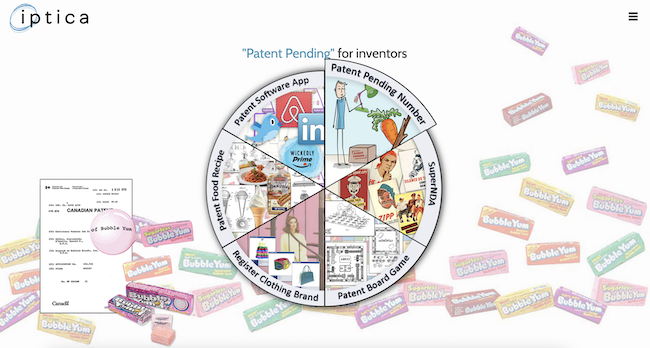Introduction to patents
What is a patent?
Patents protect inventions that are new, inventive and capable of being used in trade, industry or agriculture. Whereas: designs protect the shape of articles; trademarks protect trading names and brands; and copyright protects works reduced to material form from being copied, patents protect the technical principle of an invention.
Tip: When meeting inventors, we ask them to point to the new physical feature that they have added to the product without mentioning applications / use.
If you cannot point to anything, there typically is nothing patentable. If you can identify a feature, conduct a patent search to determine if it is new. If so, that feature may be patentable.
A patent prevents others from making, using, exercising, disposing of (selling, leasing, etc) or importing the invention for a period of 20 years. Patents are territorial. To secure patent protection in a country you must file a patent in that country. There is no such thing as a “world wide patent”.
In South Africa, the process for obtaining patent protection generally comprises the steps of conducting a novelty search, filing a provisional patent application and, 12 months later, filing a complete patent application. If the inventor wishes to file patents in more than three other countries, he should file a PCT (international) application, followed by national phase patent applications in each of the countries. Easily self-file South African and Nigerian national phase patents through GlobalIPCo using our provisional patent drafting and filing guide.
Note: the PCT patent does not itself develop into a patent. It merely extends the period in which an inventor may file patents in other countries from 12 months after filing a provisional patent application to 30 months.
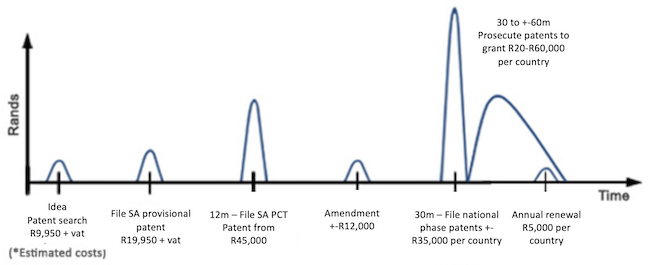
Rights secured by a patent
Patent rights are defined by the claims. Any product that includes the features described in a patent claim infringes that patent. The existence of additional features is irrelevant to the question of infringement. However, it is possible that the inventor of these additional features may obtain patent protection for such features, if new.
For example, the first person (Mrs X) to invent a pencil, could have obtained a 20 year monopoly for the following principle:
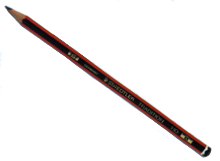
A writing instrument including:
an elongate body defining a central bore; and
a writing element sized to fit within the central bore.
Assuming that another person (Mr Y) invented the standard pen, he would have to pay a royalty to Mrs X to make the pen, but would also be entitled to patent protection for the following principle:

writing instrument including:
a reservoir for storing a fluid;
an elongate body for housing the reservoir; and
a nib on at least one end of the reservoir for controlling flow of fluid from the reservoir.
Now assuming that Mrs Z creates a click-type pen, she would have to pay royalties to both Mrs X and Mr Y, but would be able to secure patent protection for the following principle:

A writing instrument including:
a reservoir for storing a fluid;
an elongate body for housing the reservoir;
a nib on at least one end of the reservoir for controlling flow of fluid from the reservoir, the nib being movable between an operable position, wherein the nib protrudes from the body, and an inoperable position, wherein the nib is housed within the body; and
a means for actuating the nib between the operable and inoperable positions.
Read more: Understanding patent claims
Reason for filing a patent
After a major storm hit the East London harbour in 1963, Eric Mowbray Merrifield, an East London harbour engineer, began considering methods to dissipate rather than block the wave energy. Merrifield wanted a massive element designed in such a way that it could be “sprinkled like children’s jacks” – presenting little surface area to the wave action and making them difficult to dislodge.
Kruger went home for lunch, cut three sections off the end of his wife’s broomstick, nailed them together into an H-shape with one leg turned through 90 degrees, and the dolos was born.

Being easy and cheap to manufacture and simple to distribute along shorelines, the dolos proved an immediate success worldwide. Each kilometre of shoreline requires ten thousand 20 ton doloses, and millions having been scattered along beaches.
Pitfall 1 – do not pass up the opportunity of protecting your intellectual property without good reason.
Unfortunately for Merrifield and Kruger, no patent or design protection for the dolos was secured, and no commercial benefit was received by either inventor for this incredibly successful invention.
The importance of conducting a novelty search
After coming up with an invention, and before patenting, you should always conduct a novelty search. Failure to do so may cause you to incur unnecessary expenses, time and effort in developing and commercialising inventions that are not protectable.
Pitfall 2 – do not assume that your invention is new. Conduct a search.
On September 14, 1964, the Al Kuwait freighter carrying 5000 sheep capsized and sank in the Kuwait harbour. As time went by, the freighter’s decomposing cargo threatened to contaminate the city’s drinking water supply, which was sourced from the harbour. An effective method of salvaging the Al Kuwait freighter was required.
Bringing cranes in would have taken too long and the risk of the freighter breaking apart during salvage was unacceptable. Fortunately, Karl Kroyer dreamt up an alternative method of raising sunken vessels. It involved pumping a number of buoyant bodies into the vessel through a tube until the buoyant bodies provided sufficient upward lift to float the vessel.
On 31 December 1964 Mr Kroyer pumped 27 million expandable polystyrene foam balls into the freighter and floated it, saving the insurance company that had insured the freighter in excess of $1,500,000.
In the meantime, Mr Kroyer filed a patent application at the Danish Patent Office. This application was later extended to Germany, the Netherlands and the United Kingdom. In his application, Mr Kroyer claimed:
“a method of raising sunken or stranded vessels by introducing into the interior of said vessel buoyant bodies by means of a stream of water, characterised in that said stream of water is passed through an ejector and that the buoyant bodies are introduced into said stream of water through the suction tube of said ejector”.
The figure below accompanied Mr Kroyer’s application.

Although his salvage method had proven successful and resulted in the grant of patents in both Germany and the United Kingdom, Mr Kroyer’s patents were about to be undermined by a Donald Duck comic book.
Patent “legend” has it that although Kroyer’s invention was considered novel by the German and UK Patent Offices, the Dutch Patent Office had discovered a relevant piece of prior art. The prior art discovered was not found in a patent database but in a 1949 Donald Duck comic book entitled “The Sunken Yacht” (by Carl Barks – Walt Disney)
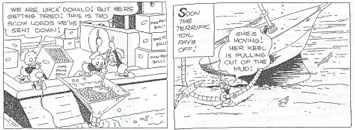
The comic book showed Donald Duck and his nephews raising a yacht by filling it with ping pong balls fed through a tube. The Dutch Patent Office refused to grant a patent for the invention on the ground that the comic book disclosed the same technique as that claimed in Kroyer’s patent. On the basis of this disclosure, all patents filed by Mr Kroyer appeared to lack novelty and were invalid.
An invention must be new to be patentable. If an invention has been disclosed to the public in any way, anywhere in the world prior to filing a patent application, the invention is no longer patentable. Even the disclosure of the invention by the inventor on a non-confidential basis to his best friend is novelty destroying.
Pitfall 3 – do not rely on novelty searches conducted through the records of the South African Patent Office.
Many inventors conduct patent searches at our Patent Office. This is not encouraged: our Patent Office records are incomplete and not maintained “up to date”; some searchers remove relevant patent abstracts instead of making a photocopy thereof; and less than 3% of inventions worldwide are filed in South Africa.
Only conduct South African patent searches for technology where South Africa is recognised as a world leader, e.g. mining equipment, techniques and processes and automatic pool cleaners.
Pitfall 4 – just because your invention has not previously been commercialised does not mean that it is new.
There are two chestnuts that a patent attorney is guaranteed to see every year – aeroplane tyres with fins and a front brake light for a car.
Standing at O.R. Tambo International and watching the aeroplanes land, the benefits of pre-rotating the aeroplane tyres prior to landing are obvious – tyres making contact with the runway have to accelerate from zero to over 350 kilometres per hour within a fraction of a second. The friction wears the tyres and generates a cloud of smoke.
Using the wind speed to pre-rotate the tyres while in flight, should improve tyre life. And, a simple way of converting wind speed into wheel rotation is to add fins or cups to the outer walls of the tyres.
Despite the obvious commercial benefits, a quick search through the US Patent Office database reveals that this technology is more than 40 years old and has never been put into practice.
Search String Example
The keywords (and all variations thereof) are:
- airplane or aeroplane or aircraft;
- tyre or tire or wheel;
- rotate or rotating or rotation or spin or spinning or turn or turning;
- wind; and
- land or landing.
Patents are generally broken up into a number of sections, namely a title, an abstract, a body and claims. Categorise the keywords into the relevant sections and use wildcard characters (i.e. $ symbol for US Patent Office searches) to reduce the length of search strings.
The keywords “airplane or aeroplane or aircraft” are likely to appear in the title of the patent (field code ttl/ for US Patent Office searches) and the rest of the keywords should appear in the abstract (field code abst/ for US Patent Office searches). The appropriate search string is:
“ttl/( airplane or aeroplane or aircraft) and abst/((tyre or tire or wheel) and (rotat$ or spin$ or turn$) and wind$ and land$)”
This search reveals six possible pre-existing patents, including US6,032,900 entitled “Aircraft Wheel Rotating Device”. In turn, these six patents open a pandora’s box containing hundreds of other patents describing similar concepts.
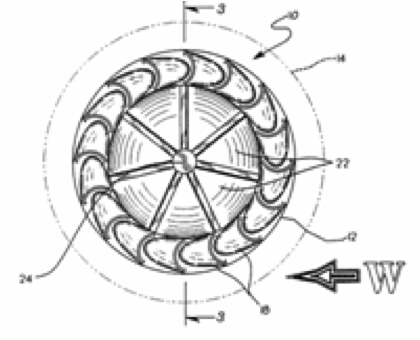
An invention must not be obvious to a skilled person to be patentable
Fuses or shock tubes were introduced to the mining, quarrying and construction industries in the early 1970’s as a method of initiating explosions. These tubes had a fine layer of explosive dust on their inner walls. The detonator at one end of the tubes initiated an explosive wave along the tube to detonate a charge at the other end. However, this explosive coating would dislodge from the inner wall during transportation and installation, resulting in misfires.
To make the tube more resistant to impact Ensign Bickford added an outer tube over the inner tube. During handling, this outer tube absorbed most of the impact that would have otherwise dislodged the explosive dust from the inner tube.
Ensign Bickford obtained a patent for this invention, which was subsequently challenged on the ground of obviousness. The court found that merely adding a shock absorbent coating to an impact sensitive article would have been obvious to an expert in the field, and revoked the patent due to the absence of an inventive step.
This was the first of only three South African patents that have ever been revoked on the ground of lack of inventiveness.
Pitfall 5 – do not jointly own a patent without a joint ownership agreement that regulates the owners’ rights in respect of the patent.
According to South African law, in the absence of a joint ownership agreement to the contrary, each co-owner holds equal undivided shares in the application and none of the owners may without the consent of the other joint owners exercise any patent rights.
Family members generally consider joint ownership agreements unnecessary … until a dispute arises.
Pitfall 6 – do not leave out important information or fail to describe alternative embodiments of your invention in your provisional patent application.
The consequences of not describing your invention fully are illustrated in the following example:
After becoming one of the most popular water sports in the world, windsurfing was awarded Olympic status at the 1984 Los Angeles Games. Unbeknown to the inventors, the validity of their patents was about to be challenged, resulting in the revocation of their United Kingdom patent no more than a year later.
The inventors of the windsurfer were James Drake – an aeronautical engineer who enjoyed sailing – and Hoyle Schweitzer – a computer analyst and a surfer. Together, they came up with the concept of attaching a sail to a surfboard, providing the exhilaration of surfing without the need for a wave.
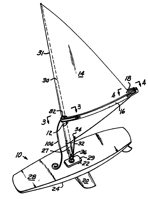
The first patent application was filed in the US in 1968 and later extended to Australia, Canada, Germany and the United Kingdom. The UK patent, which was granted in the early 1970’s under patent number GB 1,258,317, claimed:
A wind-propelled vehicle comprising body means, an unstayed spar connected to said body means through a joint which will provide universal-type movement of the spar in the absence of support thereof by a user of the vehicle, a sail attached along one edge thereof to the spar, and a pair of arcuate booms, first ends of the booms being connected together and laterally connected on said spar, second ends of the booms being connected together and having means thereon connected to the sail such that said sail is held taut between the booms.
During subsequent revocation proceedings previous windsurfers with generally similar configurations (including straight booms that became curved to some degree when sailed) came to light. James Drake argued that the patented windsurfer represented a material advancement in that the sail adopted the shape of an aerofoil, which significantly improved its sailing characteristics, and that this shape was induced by the arcuate booms. However, the patent merely stated that the arcuate booms provided a grip for the user and held the sail taut – a purpose that straight booms would achieve just as effectively – and failed to explain the ancillary, novel function of these booms.
Based on this omission, the Court upheld the application for revocation and revoked the patent on the grounds of insufficient disclosure and lack of novelty. South African patent law closely mirrors the law in the United Kingdom with regard to grounds of revocation. Therefore, if registered, any corresponding South African patent would likely have suffered a similar fate.
The patent race has only just begun
Many inventors are under the impression that once their provisional application has been filed, the money will start rolling in. Unfortunately, this is not the case.
Pitfall 7 – do not sit back and relax after filing your provisional patent application.
The patent race has only just begun. You have 12 months from filing the provisional application to raise funds for your PCT patent. The success of your patenting strategy depends largely on the actions you take during this period.
This time must be used to assess the commercial value of your invention and, if you intend to file a PCT application, to focus on raising the required funding. The likely downstream costs of an international patenting program are:
- 30 months – file patent applications in select territories: R25,000 to R45,000 per country
- 30-66 months – prosecute foreign patent applications to grant: R25,000 to R70,000 per country
- annual renewal fees – R800 to R12,000 per country (see our Online Renewal System)
Instead of focusing time on “perfecting” the product – the product does not need to be perfect to attract investors – rather focus on obtaining government grants or venture capital (VC) funding. But bear in mind that the probability of securing finance from these sources seldom exceeds 20% and generally takes 6 to 12 months to secure.
Too often, licensing as a source of funding is overlooked by inventors. A licensee that assumes the costs of patenting in his licensed territory in consideration for a discounted royalty rate is a “gift-horse”. Second and third prizes are licences that provide for either an upfront licence fee with discounted running royalties or a royalty pre-payment. As a last resort, provide for guaranteed minimum royalty payments, which can be discounted to a financier.
Tip: Use our licensing term sheet to negotiate watertight licenses.
Tip: Save up to 70% on patent renewals worldwide by paying your renewal fees / maintenance fees / annuities online.
Only after overcoming the funding obstacle, should your focus revert to perfecting and marketing the product … and, of course, remember to consult your patent attorney at least 4 weeks before expiry of the 12 month period to commence with the drafting and filing of your complete or PCT application.
Patenting new applications for existing inventions?
To reduce wear on shoes, various patents were filed prior to the 1960’s for composite heels with metal plates. Drummond-Hay worked in the mines and noticed that miners’ boots tendered to slip in the wet stope environment. To remedy this, Drummond-Hay created a boot with an integrally moulded metal plate that semi-protruded from the heel and filed South African patent No. 22967 entitled “Improvements in heels for miners’ boots”.
Drummon-Hay’s boot was subsequently copied by DI Fram Company Limited resulting in infringement proceedings. DI Fram counter-claimed that Drummond-Hay’s boots were not novel. In his defence, Drummond-Hay argued that: (i) his configuration, although not necessarily new, prevented slippage in addition to reducing wear; and (ii) related specifically to a miner’s boot – the prior patents, which related to footwear in general, did not describe this additional benefit in their descriptions.
The court held that the heels described in the prior patents would similarly have prevented slippage, and that it was not relevant that this benefit was not described in the patents.
A new use for an existing product is not patentable. But this principle does not necessarily extend to pharmaceuticals.
“Patent Pending” for marketing and deterrence
Apart from “protection”, patents are also useful for “marketing” (think Pantene Pro-V and Audi’s advert for the A6 “more patents than NASA”) and “deterrence”. Iptica‘s Patent Pending Number is a great site for obtaining Patent Pending Numbers and seeing how software, food clothing and board game companies used patents in creative ways. Iptica will broaden your view of patents.
